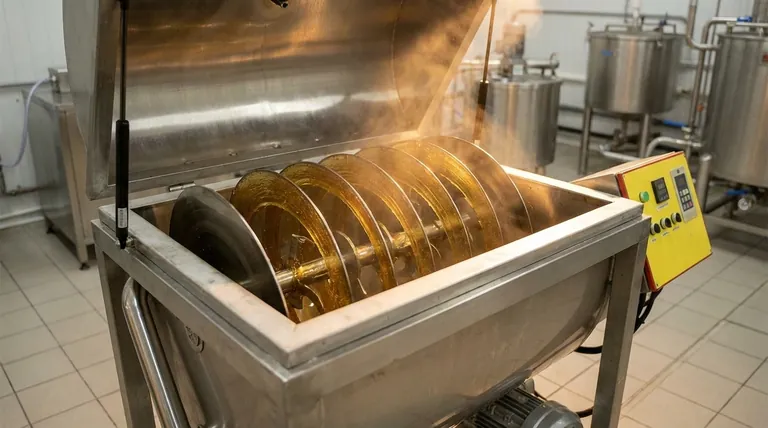The primary role of heated air in a honey dryer is not to "cook" the honey, but to create a precisely controlled dry microclimate. This dry environment actively encourages and accelerates the evaporation of excess water from the honey, lowering its moisture content to a safe and stable level.
The core function of heated air is to lower the relative humidity inside the dryer. This turns the air into a "thirsty" agent that efficiently pulls moisture from the honey, preventing fermentation and ensuring a high-quality, shelf-stable product.

The Core Problem: Why Honey Moisture Matters
Honey is a supersaturated sugar solution, but its stability is directly tied to its water content. When honey is harvested, especially during humid conditions or before it's fully "capped" by bees, it can contain too much water.
The Risk of Fermentation
Excess moisture, typically anything above 20%, creates an environment where naturally occurring osmophilic yeasts can thrive. These yeasts consume the honey's sugars, producing alcohol and carbon dioxide, which leads to fermentation, spoilage, and an "off" taste.
The Standard for Quality
For honey to be considered stable and high-quality, its moisture content must be below a certain threshold. The industry standard for premium honey is a moisture level between 17% and 18%. Achieving this precise target is the primary goal of a honey dryer.
How Heated Air Solves the Moisture Problem
A honey dryer uses a simple but powerful principle of physics to remove water. The key is not the heat itself, but what the heat does to the air.
The Principle of Relative Humidity
Warm air has the capacity to hold significantly more moisture than cold air. When you heat the air inside a dryer, you dramatically lower its relative humidity, even if the absolute amount of water vapor in it remains the same. This creates an artificially dry environment.
Creating a "Moisture Gradient"
This low-humidity air creates a steep moisture gradient between the air and the honey. The water in the honey is at a high concentration, while the "water-holding capacity" of the surrounding air is also high. Following the laws of physics, water molecules naturally evaporate from the honey's surface to equalize this imbalance.
The Role of Air Circulation
To be effective, this now-moist air must be constantly moved away from the honey's surface and replaced with fresh, dry, heated air. This continuous circulation ensures the evaporation process does not slow down, efficiently carrying moisture out of the system.
Understanding the Trade-offs
Using heated air is a balancing act. While effective, applying heat without precision can cause its own set of problems.
The Danger of Overheating
Honey contains delicate enzymes and aromatic compounds that give it its unique flavor, aroma, and health benefits. Excessive heat can denature these enzymes and destroy the volatile compounds, fundamentally damaging the quality of the final product.
Balancing Speed vs. Quality
A higher temperature will dry the honey faster, but it also increases the risk of damage. The goal of professional honey processing is not simply speed, but gentle and controlled moisture removal. A well-designed dryer maintains the lowest effective temperature required to achieve the target humidity, preserving the honey's natural character.
Making the Right Choice for Your Process
Your goal determines how you should approach honey drying. The process is about control, not just heat.
- If your primary focus is simply preventing spoilage: Your main goal is to consistently bring the honey's moisture content below the 20% fermentation threshold.
- If your primary focus is achieving premium, marketable quality: Your goal is precise control to hit the 17-18% moisture "sweet spot" without damaging the honey's delicate enzymes and aromas.
By mastering the principles of moisture removal, you gain direct control over the stability and quality of your final product.
Summary Table:
| Aspect | Key Detail |
|---|---|
| Primary Role | Creates a low-humidity microclimate to accelerate water evaporation. |
| Target Moisture | Industry standard for premium honey is 17-18%. |
| Risk of High Moisture | Fermentation (above 20% moisture) from yeast activity. |
| Critical Balance | Gentle heat application to avoid damaging delicate enzymes and aromas. |
Achieve Perfect Honey Quality with Professional Equipment
Mastering the delicate balance of moisture removal is key to producing stable, high-quality honey that commands a premium price. The right equipment provides the precise control you need to protect your honey's natural character while ensuring it meets industry standards.
HONESTBEE specializes in supplying durable, efficient honey processing equipment designed for the demands of commercial apiaries and distributors. Our solutions help you safeguard your product quality and maximize your yield.
Contact our experts today to discuss how our honey dryers and processing supplies can optimize your operation and protect your product's integrity.
Visual Guide

Related Products
- Economy Small Scale Honey Dryer Dehumidifier Thickening Machine
- 0.5T Capacity Honey Dehumidifier Dryer with Vacuum Heating and Thickening Filtering Machine
- High Quality Honey Dehumidifier Dryer Thickening Machine for Beekeeping
- HONESTBEE 72 Frame Industrial Electric Honey Extractor for Beekeeping
- Premium Diamond-Faceted Glass Honey Dispenser
People Also Ask
- How to reduce moisture level in honey? Preserve Quality and Prevent Fermentation
- What are the advantages of a condensation honey dryer? Boost Quality & Yield for Your Apiary
- Can you dehumidify honey? A Beekeeper's Guide to Preventing Fermentation
- How much honey can a honey dryer process and by what percentage does it reduce moisture? Optimize Your Honey Production
- How does temperature regulation help in managing honey moisture content? Prevent Fermentation & Ensure Quality



















